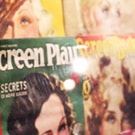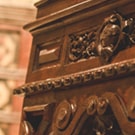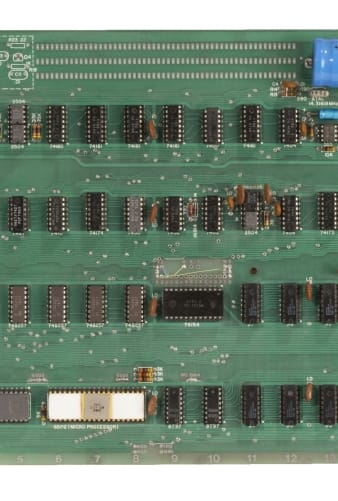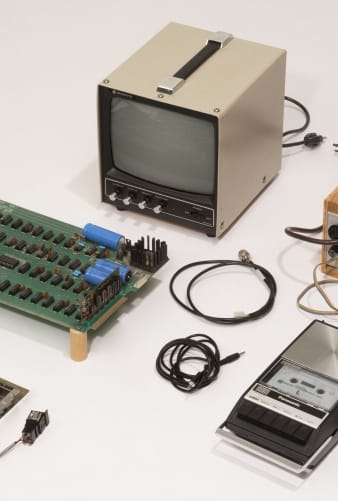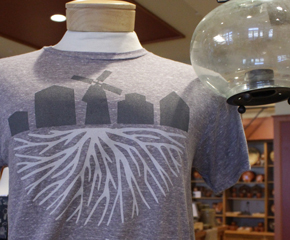
The Henry Ford
Archive of American Innovation™
Innovation Focus
Our collecting continues to focus on resourcefulness, innovation, and ingenuity—and both new and old artifacts, along with their stories, are featured in new ways. In particular, as digital technologies became ubiquitous, The Henry Ford began developing new strategies to accomplish its mission to share, teach, and inspire, particularly focused on the “innovation” portion of the mission statement.
The Henry Ford Archive of American Innovation™ represents the core assets of The Henry Ford that illustrate the process and context of innovation. It refers to artifacts and documents in the collection that provide an unprecedented window into America’s traditions of resourcefulness, innovation, and ingenuity. It is the key to understanding how our entire modern world was created.
Related stories of artifacts and innovation are featured on The Henry Ford’s Innovation Nation, a weekly educational TV program produced by Litton Entertainment and hosted by Mo Rocca, which has aired since Fall 2014. Innovation is also brought in through events such as Maker Faire Detroit, hosted annually at The Henry Ford since 2010.

The Apple 1 was not only innovative, but it is a key artifact in the foundation of the digital revolution.
 Patricia Mooradian
President, The Henry Ford
Patricia Mooradian
President, The Henry Ford
A Key Innovation Artifact
One of the most significant artifacts collected during this period was the Apple 1, added to the collection in October 2014. Less than 70 Apple 1’s are known to exist, and only 15, including The Henry Ford’s, are operational. Curator of Information Technology and Communication Kristen Gallerneaux noted that this artifact is “a powerful and humanized example of information technology that is absolutely bursting with stories of innovation, ingenuity, and resourcefulness”—a perfect addition to the Archive of American Innovation.
"Partio" Cart Used by Dwight Eisenhower, circa 1960
Artifact
Barbecue grill
Date Made
circa 1960
Summary
The upscale Partio -- an all-in-one electric range, charcoal barbeque, and rotisserie -- evokes America's sense of optimism during the Eisenhower era. This particular example was owned by Dwight D. Eisenhower and used by the former President at his Palm Springs, California, home. Vivid postwar styling aside, the Partio points forward to the present day interest in well-appointed outdoor living, as served up in lifestyle magazines and lavish catalogues.
Creators
Place of Creation
Object ID
2012.24.1
Credit
From the Collections of The Henry Ford. Purchased with funds from the Carleton & Hazel Brown Collection Fund.
Location
Not on exhibit to the public.
Get more details in Digital Collections at:
"Partio" Cart Used by Dwight Eisenhower, circa 1960
What is The Henry Ford?
The national attraction for discovering your ingenuity while exploring America’s spirit of innovation. There is always much to see and do at The Henry Ford.
Korn "Indianapolis 29" Gas-Powered Racing Tether Car, 1948
Artifact
Model car
Date Made
1948
Summary
Tether cars, gasoline-powered model race cars, were popular in the 1930s and 1940s. They were raced individually while tethered to a central pivot, or against each other on a scaled-down board track. This model of an Indianapolis-style car was built by Barney (B.B.) Korn. It used a .29-cubic-inch engine. While Korn's models weren't particularly fast, they showed exceptional craftsmanship.
Place of Creation
Keywords
Object ID
2013.47.83
Credit
From the Collections of The Henry Ford. Gift of Eric Zausner and the E-Z Spindizzy Foundation.
On Exhibit
at Henry Ford Museum in Driven to Win: Racing in America
Get more details in Digital Collections at:
Korn "Indianapolis 29" Gas-Powered Racing Tether Car, 1948
What is The Henry Ford?
The national attraction for discovering your ingenuity while exploring America’s spirit of innovation. There is always much to see and do at The Henry Ford.
Rinso with Sunshine Whiteners, 1964-1969
Artifact
Soap packaging
Date Made
1964-1969
Creators
Place of Creation
Object ID
2012.88.203
Credit
From the Collections of The Henry Ford. Gift from the Collection of Susan Strongman Fiems by Dennis Fiems.
Location
Not on exhibit to the public.
Get more details in Digital Collections at:
Rinso with Sunshine Whiteners, 1964-1969
What is The Henry Ford?
The national attraction for discovering your ingenuity while exploring America’s spirit of innovation. There is always much to see and do at The Henry Ford.
Kiosk From IBM Pavilion at the 1964 New York World's Fair
Artifact
Kiosk
Date Made
1963-1964
Summary
The kiosk, designed by the office of Charles and Ray Eames, is the sole survivor of several similar small structures installed within the vast IBM Pavilion at the 1964 New York World's Fair. Its light-hearted appearance -- suggesting carousel, fairground, and bandstand architecture -- was a counterbalance to the highly advanced computing technologies IBM was showcasing in the pavilion.
Place of Creation
Object ID
2013.78.1
Credit
From the Collections of The Henry Ford.
Get more details in Digital Collections at:
Kiosk From IBM Pavilion at the 1964 New York World's Fair
What is The Henry Ford?
The national attraction for discovering your ingenuity while exploring America’s spirit of innovation. There is always much to see and do at The Henry Ford.
Rod Millen, Toyota Tacoma, Pikes Peak Hill Climb, Pikes Peak, Colorado, June 14, 1998
Artifact
Slide (Photograph)
Summary
First held in 1915, Colorado's Pikes Peak International Hill Climb is known as the "Race to the Clouds." Cars climb 4,270 feet over the 12.42-mile race course. Drivers negotiate 156 turns along the twisting mountain route. Few of those turns are protected by guard rails, and some have drop-offs exceeding 1,000 feet.
Creators
Keywords
Object ID
2011.125.16
Credit
From the Collections of The Henry Ford. Photographs Gift of John G. Clark.
Location
By Request in the Benson Ford Research Center
Get more details in Digital Collections at:
Rod Millen, Toyota Tacoma, Pikes Peak Hill Climb, Pikes Peak, Colorado, June 14, 1998
What is The Henry Ford?
The national attraction for discovering your ingenuity while exploring America’s spirit of innovation. There is always much to see and do at The Henry Ford.

Video Game, "E.T. the Extra-Terrestrial," Recovered from Landfill, Alamogordo, New Mexico, April 26, 2014, Site of the Atari Video Game Burial of 1983
 Details
Details
Video Game, "E.T. the Extra-Terrestrial," Recovered from Landfill, Alamogordo, New Mexico, April 26, 2014, Site of the Atari Video Game Burial of 1983
Artifact
Video game
Date Made
1982
Summary
In 1983, rumors circulated: Atari was bankrupt, and was dumping truckloads of games into a New Mexico landfill. Victim to the "Video Game Crash," the company buried 700,000 cartridges in the desert. The story became an obscure pop culture legend -- until "The Atari Tomb" was unearthed in 2014. This recovered cartridge is evidence of the world's first video game excavation.
Object ID
2015.13.1
Credit
From the Collections of The Henry Ford. Gift of the City of Alamogordo, New Mexico.
Get more details in Digital Collections at:
Video Game, "E.T. the Extra-Terrestrial," Recovered from Landfill, Alamogordo, New Mexico, April 26, 2014, Site of the Atari Video Game Burial of 1983
What is The Henry Ford?
The national attraction for discovering your ingenuity while exploring America’s spirit of innovation. There is always much to see and do at The Henry Ford.
La-Z-Boy Chair Company Sales Model "Reclina Rocker" Chair, 1961
Artifact
Reclining chair
Date Made
1961
Summary
The first to combine a built-in ottoman with a rocking feature, this model dramatically increased La-Z-Boy's sales in the early 1960s. Middle class Americans eagerly adopted the chair for use in dens, family and living rooms. This chair served as William M. Clary's La-Z-Boy salesman sample, traveling the country from dealer to dealer.
Creators
Place of Creation
Keywords
Object ID
2015.78.2
Credit
From the Collections of The Henry Ford. Gift of La-Z-Boy, Incorporated.
Get more details in Digital Collections at:
La-Z-Boy Chair Company Sales Model "Reclina Rocker" Chair, 1961
What is The Henry Ford?
The national attraction for discovering your ingenuity while exploring America’s spirit of innovation. There is always much to see and do at The Henry Ford.
Apple 1 Computer, 1976
Artifact
Computer
Date Made
1976
Summary
This is one of the first 50 Apple 1 computers. Apple 1s were the first pre-assembled personal computers; Steve Wozniak assembled this one in Steve Jobs's family home. Before the release of the Apple 1, owning a personal computer meant building it yourself. Wozniak's refined engineering skills, coupled with Jobs's bold marketing abilities, led to a revolutionary and affordable product--as well as a successful company.
Creators
Place of Creation
Keywords
Object ID
2014.113.1
Credit
From the Collections of The Henry Ford.
Location
Not on exhibit to the public.
Get more details in Digital Collections at:
Apple 1 Computer, 1976
What is The Henry Ford?
The national attraction for discovering your ingenuity while exploring America’s spirit of innovation. There is always much to see and do at The Henry Ford.
Driver Seated in Dragster at Langhorne Speedway Drag Races, 1960
Artifact
Negative (Photograph)
Summary
Langhorne Speedway, located near Philadelphia, Pennsylvania, usually hosted stock car and open-wheel races. But after an asphalt strip was added to the infield in 1958, Langhorne hosted 1/8-mile drag races too. Drag racing ended at Langhorne Speedway following the 1964 season. The speedway itself permanently closed in October 1971.
Creators
Object ID
2011.149.6
Credit
From the Collections of The Henry Ford.
Location
By Request in the Benson Ford Research Center
Get more details in Digital Collections at:
Driver Seated in Dragster at Langhorne Speedway Drag Races, 1960
What is The Henry Ford?
The national attraction for discovering your ingenuity while exploring America’s spirit of innovation. There is always much to see and do at The Henry Ford.
Unimate Industrial Robot in Use in Factory, 1968-1975
Artifact
Photographic print
Summary
George Devol revolutionized manufacturing with his invention of the Unimate -- the world's first industrial robot. These rugged programmable units were designed to perform repetitive, arduous and hazardous tasks. The first Unimate was installed in a General Motors plant in 1961. This photograph, part of a larger archival collection documenting Devol's work, illustrates the functions and uses of his innovative idea.
Keywords
Object ID
2012.64.344
Credit
From the Collections of The Henry Ford. Donated by the Family of George C. Devol.
Location
By Request in the Benson Ford Research Center
Get more details in Digital Collections at:
Unimate Industrial Robot in Use in Factory, 1968-1975
What is The Henry Ford?
The national attraction for discovering your ingenuity while exploring America’s spirit of innovation. There is always much to see and do at The Henry Ford.
Active Collecting
Though the world has become increasingly digital, The Henry Ford continues to collect hundreds or even thousands of physical artifacts each year. In the second decade of the 21st century, this has included material related to significant artifacts we already hold (John F. Kennedy material, to add additional context to the Kennedy Limousine; and the George Devol collection, which relates to the world’s first industrial robot), design (an Eames-designed, IBM-used kiosk and hundreds of examples of 20th century soap packaging), and auto racing (photographic collections from John Clark and Ray Masser and dozens of tether cars or “spindizzies”).
Major recent acquisitions include the John Margolies Roadside America collection, the Bachmann studio collection of American glass, the Roddis clothing collection, and Mathematica, a circa 1960 exhibit designed by Charles and Ray Eames.
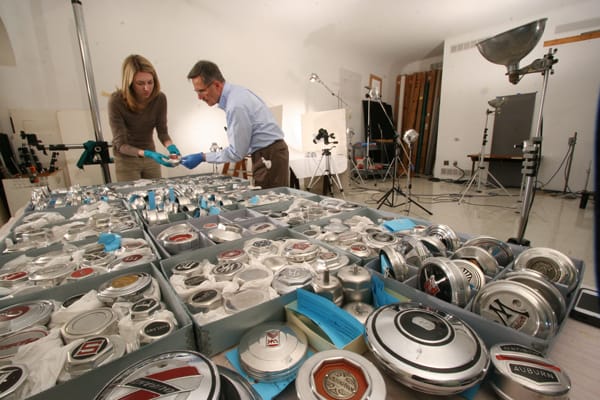
The Collections Go Digital
The Henry Ford began scaling up its collections digitization effort in 2010, hiring new staff with new skills to advance this technology-intensive effort that involves conservation, cataloging, photography, and scanning. Images of tens of thousands of artifacts are now freely available online, from our Digital Collections, and provide the basis for additional layers of supporting content, helping the public to understand artifacts in the context of their original time and place as well as the context of today.
Digitization efforts include artifacts on display within the Museum or Village, new acquisitions, and “hidden” items currently in storage. In 2013–15, for example, more than 1200 communications-related artifacts in storage, including many significant rediscovered treasures, were digitized through a grant from the Institute for Museum and Library Services (IMLS).
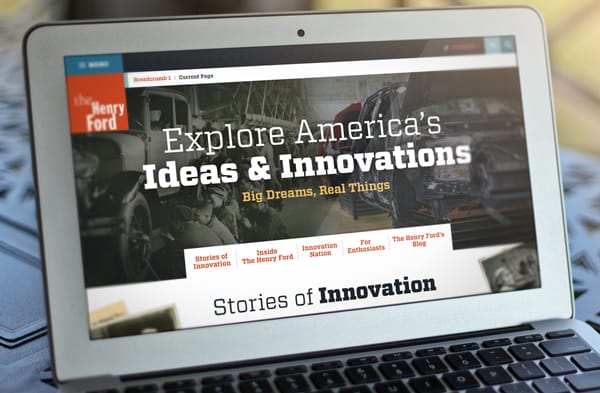
From Digital Artifacts to Digital Stories
While more than 20,000 artifacts are on public exhibit in Henry Ford Museum, Greenfield Village, the Benson Ford Research Center, and the Ford Rouge Factory Tour, The Henry Ford’s collection holds many more—about 250,000 objects and millions more photographs and documents within our archives. Institutional commitment to the digitization of The Henry Ford Archive of American Innovation™ is making these collections, and the ideas behind them, more accessible to more people in more ways than ever.
Within Henry Ford Museum and the Ford Rouge Factory Tour, digital collections and their stories can be accessed on touch-screen kiosks; within The Henry Ford’s website, anyone with internet access can browse videos highlighting surprising connections between artifacts when visiting our Connect3 series. You can also listen to clips from interviews with famous innovators from our oral history project, Collecting Innovation Today, and artifact-based stories imagining “What If?”



















